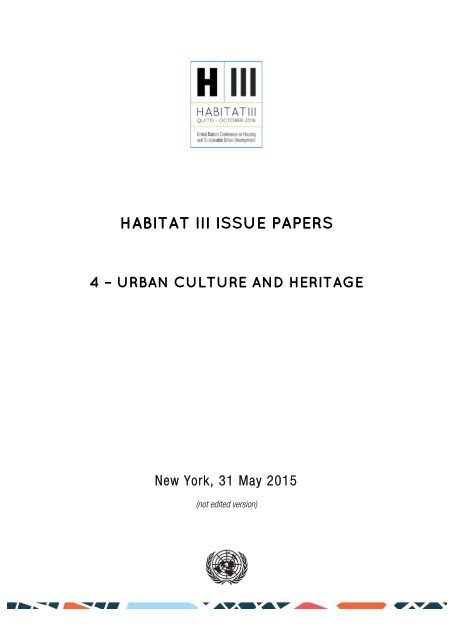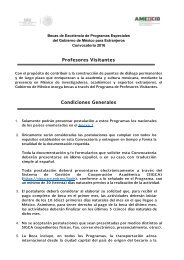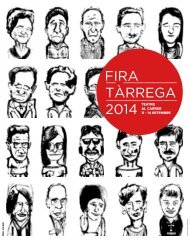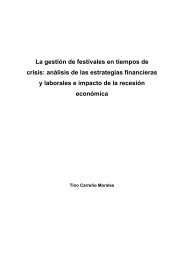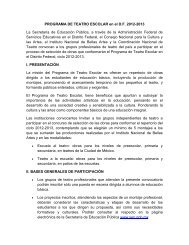Habitat-III-Issue-Paper-4_Urban-Culture-and-Heritage
Habitat-III-Issue-Paper-4_Urban-Culture-and-Heritage
Habitat-III-Issue-Paper-4_Urban-Culture-and-Heritage
You also want an ePaper? Increase the reach of your titles
YUMPU automatically turns print PDFs into web optimized ePapers that Google loves.
HABITAT <strong>III</strong> ISSUE PAPERS<br />
4 – URBAN CULTURE AND HERITAGE<br />
New York, 31 May 2015<br />
(not edited version)
ISSUE PAPER ON URBAN CULTURE AND HERITAGE<br />
KEY WORDS<br />
culture-based regeneration, urban heritage conservation, urban l<strong>and</strong>scape, cultural <strong>and</strong> creative industries, cultural<br />
values, cultural diversity, creative economy, inclusive development, social cohesion, right to cultural heritage,<br />
density, mixed-use, strategic territorial governance<br />
MAIN CONCEPTS<br />
1. <strong>Culture</strong>, according to the UNESCO Universal Declaration on Cultural Diversity (2001), is “the set of distinctive<br />
spiritual, material, intellectual <strong>and</strong> emotional features of a society or a social group that encompasses art <strong>and</strong><br />
literature, lifestyles, ways of living together, value systems, traditions <strong>and</strong> beliefs”. <strong>Urban</strong> culture thus covers<br />
the notions of culture within an urban setting, from both a functional <strong>and</strong> anthropological perspective.<br />
2. Cultural <strong>and</strong> creative industries are those sectors of activity that have as their main objective the creation,<br />
production, distribution <strong>and</strong> consumption of goods, services <strong>and</strong> activities that have cultural <strong>and</strong> artistic<br />
content. They are characterized by being at the intersection of economy <strong>and</strong> culture, having creativity at the<br />
core of their activities, artistic <strong>and</strong>/or cultural content, <strong>and</strong> links to innovation. Cultural <strong>and</strong> creative industries<br />
include cinema <strong>and</strong> audio-visual arts, design <strong>and</strong> crafts, media arts, music, performing arts, publishing <strong>and</strong><br />
visual arts.<br />
3. Creative cities are defined as urban complexes where cultural activities are an integral component of the city’s<br />
economic <strong>and</strong> social functioning, for example through support to cultural <strong>and</strong> creative professionals, enhanced<br />
investments in cultural infrastructure, creative industries <strong>and</strong> new ICTs, or the adoption of bottom-up<br />
approaches to urban development.<br />
4. Historic urban l<strong>and</strong>scape is an urban area understood as the result of a historic layering of cultural <strong>and</strong> natural<br />
values <strong>and</strong> attributes, extending beyond the notion of “historic centre” or “ensemble” to include the broader<br />
urban context <strong>and</strong> its geographical setting: sites’ topography, geomorphology, hydrology <strong>and</strong> natural features,<br />
built environment, both historic <strong>and</strong> contemporary, infrastructures above <strong>and</strong> below ground, open spaces <strong>and</strong><br />
gardens, l<strong>and</strong> use patterns <strong>and</strong> spatial organization, perceptions <strong>and</strong> visual relationships, other urban structure<br />
elements. It also includes social <strong>and</strong> cultural practices <strong>and</strong> values, economic processes <strong>and</strong> the intangible<br />
dimensions of heritage as related to diversity <strong>and</strong> identity.<br />
5. <strong>Urban</strong> heritage represents a social, cultural <strong>and</strong> economic asset <strong>and</strong> resource reflecting the dynamic historical<br />
layering of values that have been developed, interpreted <strong>and</strong> transmitted by successive generations <strong>and</strong> an<br />
accumulation of traditions <strong>and</strong> experiences recognized as such in their diversity. <strong>Urban</strong> heritage comprises<br />
urban elements (urban morphology <strong>and</strong> built form, open <strong>and</strong> green spaces, urban infrastructure), architectural<br />
elements (monuments, buildings) <strong>and</strong> intangible elements. <strong>Urban</strong> heritage conservation or urban conservation<br />
1
elates to urban planning processes aimed at preserving cultural values, assets <strong>and</strong> resources through<br />
conserving the integrity <strong>and</strong> authenticity of urban heritage, while safeguarding intangible cultural assets<br />
through a participatory approach.<br />
FIGURES AND KEY FACTS<br />
• <strong>Culture</strong> plays a fundamental role in urban economies, through monetary <strong>and</strong> non-monetary values. The<br />
safeguarding <strong>and</strong> promotion of cultural heritage <strong>and</strong> creative industries open major opportunities for cities. In<br />
the developing world, they have become a key asset to create qualified jobs <strong>and</strong> reach out to vulnerable<br />
populations, in both the formal <strong>and</strong> informal sector.<br />
ü The volume of world trade of creative goods <strong>and</strong> services doubled between 2002 <strong>and</strong> 2011, reaching $<br />
624 billion. Exports of creative goods in developing countries grew 12.1% annually on average over this<br />
period. Cultural industries account for a growing portion of urban jobs, representing 16% of all jobs in<br />
Mumbai or 12% in London.<br />
ü Cultural tourism is a rapidly developing sector for cities. Tourism represents 9% of the world’s Gross<br />
Domestic Product (GDP) <strong>and</strong> higher share of Least Developed Countries (LDCs’) economies (16% of GDP<br />
in Cambodia). While 40% of all trips include a cultural element, cultural tourism grows 15% a year<br />
(against 4 to 5% for overall tourism growth).<br />
ü <strong>Urban</strong> heritage conservation is a strong economic driver. Official Development Assistance (ODA)<br />
increasingly targets urban heritage to harness this potential. Over the last 20 years, the Inter-American<br />
Development Bank (IDB) provided US$ 670 million in loans for the conservation <strong>and</strong> development of<br />
cultural heritage in Latin America. Built heritage renovation <strong>and</strong> maintenance represents 27.5% of the<br />
value of European construction industry.<br />
• With booming rural to urban migrations, urban societies have become more culturally diverse. However, the<br />
lack of appropriate urban planning <strong>and</strong> governance has affected the historic role of cities as platforms for the<br />
promotion of culture: social <strong>and</strong> spatial segregation has now become an overarching issue <strong>and</strong> new types of<br />
threats have emerged.<br />
• Threats to urban culture <strong>and</strong> heritage have significantly increased over the last 20 years. With the mounting<br />
pressures of urbanization, urban heritage faces severe conservation <strong>and</strong> safeguarding issues. Damages<br />
resulting from conflict situations have also become an important issue.<br />
• While globalization processes, facilitated by the development of ICTs, enhance interaction between cultures,<br />
they also represent a challenge for cultural diversity <strong>and</strong> the safeguarding of traditional cultural practices, with<br />
higher risks of imbalances between rich <strong>and</strong> poor countries.<br />
• Municipal authorities have become key actors of culture-based urban governance. The decentralization<br />
processes over the last decades facilitated the integration of cultural assets into urban development strategies<br />
due to an enhanced awareness of local issues by local authorities <strong>and</strong> increased participation of local<br />
communities, in both developed <strong>and</strong> developing cities.<br />
2
• Failures in urban planning models over the last decades call for culturally sensitive urban development models.<br />
The example of World <strong>Heritage</strong> Cities <strong>and</strong> Creative Cities can inspire new planning <strong>and</strong> governance models to<br />
mitigate urban conflicts <strong>and</strong> reduce cities’ ecological footprint, with a view to build more compact, inclusive <strong>and</strong><br />
resilient cities.<br />
ISSUE SUMMARY<br />
The urban crisis calls for renewed models of urban development<br />
• Globalization <strong>and</strong> an unprecedented urban growth over the last decades bring out new challenges for cities to<br />
ensure equitable access to jobs <strong>and</strong> basic services – housing, sanitation, transportation, foster social inclusion<br />
<strong>and</strong> tackle inequalities. <strong>Urban</strong> planning models adopted over the last decades – notably based on zoning <strong>and</strong><br />
private transportation – have shown their limits <strong>and</strong> contributed to urban sprawl. These unsustainable schemes<br />
have not only emphasized the cities’ vulnerability <strong>and</strong> environmental footprint, but also contributed to<br />
dehumanize urban environments in terms of scale or sense of belonging.<br />
• While cities as hubs for migrations have been enriched by a more culturally diverse population, new types of<br />
challenges to social cohesion have emerged. Social <strong>and</strong> spatial segregation, already underlined in <strong>Habitat</strong> II,<br />
have become a key issue in many cities of the world. The historical function of cities as melting pots <strong>and</strong><br />
catalysts for intercultural dialogue is now jeopardized, as wealth generated by urban growth is unevenly<br />
distributed.<br />
<strong>Culture</strong> is now recognized as a key resource <strong>and</strong> asset for sustainable urban development<br />
• <strong>Culture</strong> has historically been a driving force of urban development. Stemming from social <strong>and</strong> cultural<br />
processes, urban heritage reflects societies’ identities, expectations <strong>and</strong> visions over time. <strong>Urban</strong> culture –<br />
understood as cultural <strong>and</strong> social practices, behaviours <strong>and</strong> assets developed within urban environments – is<br />
often characterized by pluralism <strong>and</strong> paves the way for cross-fertilization <strong>and</strong> innovation.<br />
• Although the role of culture for the economic, social <strong>and</strong> environmental sustainability of cities has long been<br />
recognized at the local level, it has been marginal in most international debates on urbanization over the past<br />
40 years. <strong>Culture</strong> was mostly addressed through a sector-based approach, but rarely in a comprehensive way<br />
as a lever for sustainable urban development strategies <strong>and</strong> improvement of people’s well-being, identification<br />
<strong>and</strong> involvement.<br />
• However, since 2010, the UN General Assembly has repeatedly acknowledged the role of culture for<br />
sustainable development through several resolutions <strong>and</strong>, milestone reports related to the Post-2015<br />
Development Agenda, including the Open Working Group Proposal for Sustainable Development Goals (SDGs)<br />
which encompasses a Target dedicated to culture under the SDG on “sustainable cities”, culture is now firmly<br />
3
ecognized by the international community as a key component of strategic urban planning <strong>and</strong> a key<br />
innovation for the definition of a New <strong>Urban</strong> Agenda.<br />
Threats to urban culture <strong>and</strong> heritage have increased over the last decades<br />
• <strong>Urban</strong> heritage conservation policies are increasingly challenged by urban pressures. While urban heritage is<br />
the most represented category on the World <strong>Heritage</strong> List, urban sites are faced with critical conservation<br />
issues (unplanned infrastructure, uncontrolled tourism developments, urban densification...) which impact the<br />
physical integrity of monuments <strong>and</strong> the authenticity of the urban layout. What is at stake is to preserve, for<br />
future generations, the cities’ identities, the physical testimony of their multifaceted history <strong>and</strong> the cultural<br />
values they embody, while maintaining their accessibility for all.<br />
• Cultural heritage is increasingly targeted, especially in conflict or post-conflict areas. As visible platforms of<br />
cultural diversity, cities <strong>and</strong> their cultural institutions or historic monuments are under threat of looting or<br />
intentional destruction. As core markers of people’s identity, cultural traditions <strong>and</strong> expressions are primary<br />
targets for oppression <strong>and</strong> their interdiction constitutes a form of psychological warfare. Those attacks on<br />
cultural symbols are intended to weaken the foundations of social cohesion <strong>and</strong> threaten peoples’ integrity <strong>and</strong><br />
cultural diversity. Protecting this heritage is therefore a key security issue <strong>and</strong> heritage recovery, in postconflict<br />
situations, becomes an essential source of resilience for local communities. Peace-building processes<br />
also include consideration for the multiple interpretations of heritage. The participation of all concerned <strong>and</strong><br />
the promotion of intercultural dialogue regarding cultural heritage is in this context of utmost importance.<br />
• <strong>Urban</strong> cultural practices – traditional <strong>and</strong> contemporary – can be weakened by globalization processes,<br />
exploitation of economic resources <strong>and</strong> promotion of tourism. Tourism can potentially harm the ability of<br />
communities to safeguard <strong>and</strong> transmit their cultural practices <strong>and</strong> sites, or tend to encourage st<strong>and</strong>ardized<br />
features. Minority cultural expressions risk marginalization. Local cultural values, practices or know-how can<br />
be affected through rural to urban migrations, leading to disruption in intangible cultural practices, loss of<br />
community memory, cultural impoverishment <strong>and</strong> homogenization. Gentrification processes in historic areas<br />
can also lead to exclusion of the vulnerable communities who are the historic dwellers of these areas <strong>and</strong> the<br />
repositories of their memory.<br />
Promoting culturally-sensitive urban strategies is essential to build resilient <strong>and</strong> inclusive cities<br />
• “Re-humanizing” the city should become a strategic objective of the New <strong>Urban</strong> Agenda. Enhancing local<br />
culture <strong>and</strong> recognizing cultural diversity can be a powerful way to mitigate urban conflicts, foster tolerance,<br />
preserve the social fabric <strong>and</strong> promote pluralism. Social inclusion of disadvantaged groups, particularly in the<br />
redevelopment of urban areas <strong>and</strong> cultural spaces, can be facilitated through wider recognition of their cultural<br />
identity.<br />
• Access to culture <strong>and</strong> participation in cultural life should be an integral part of all urban policies. The<br />
representation <strong>and</strong> participation of communities in the design <strong>and</strong> implementation of culturally-sensitive urban<br />
4
policies should be promoted, to fully respect the freedom of individuals to participate, access cultural heritage<br />
<strong>and</strong> contribute to the creation of culture, including through the contestation of dominant norms <strong>and</strong> values<br />
within the communities.<br />
• Cultural infrastructures such as museums can offer civic spaces for intercultural dialogue <strong>and</strong> knowledge<br />
sharing <strong>and</strong> contribute to social cohesion <strong>and</strong> mutual underst<strong>and</strong>ing. <strong>Heritage</strong> conservation processes can<br />
serve as vectors for dialogue <strong>and</strong> inclusion, for different urban communities or social groups to build a<br />
consensus on the value of their common heritage <strong>and</strong> create a sense of belonging in the respect of their<br />
diversity.<br />
• Good practices of urban heritage conservation can inspire inclusive <strong>and</strong> holistic approaches to urban<br />
development <strong>and</strong> lay the foundations for “fit-for-purpose” planning tools <strong>and</strong> legal frameworks. Historic<br />
centres offer living laboratories of dense urban areas, with mixed functions <strong>and</strong> quality public spaces, where<br />
innovative urban approaches are experimented (including soft transportation or mixed tenure) with a view to<br />
combine the requirements of conservation <strong>and</strong> the improvement of quality of life. Vernacular heritage – based<br />
on the use of local construction materials <strong>and</strong> building techniques adapted to climate conditions – can also<br />
inspire contemporary architectural models aimed at addressing climate change <strong>and</strong> reducing energy<br />
consumption. At the wider territorial scale, historic areas can serve as models of mixed urban development<br />
<strong>and</strong> density to plan <strong>and</strong> design city extensions that meet the requirements of compactness, connectivity <strong>and</strong><br />
integration.<br />
• <strong>Culture</strong>-based urban strategies can open new paths for job creation <strong>and</strong> locally-owned economic<br />
development. Cultural <strong>and</strong> creative industries, the performing arts <strong>and</strong> heritage conservation activities can be<br />
a reservoir of qualified jobs for urban poor, in both the formal <strong>and</strong> informal sectors. The cultural industries <strong>and</strong><br />
the creative economy play a growing role in cities’ development <strong>and</strong> transformation processes <strong>and</strong><br />
increasingly contribute to local economy <strong>and</strong> employment <strong>and</strong> need to be taken into account in urban<br />
development frameworks. Safeguarding <strong>and</strong> promoting culture at the local level is a way to develop<br />
endogenous resources <strong>and</strong> create conditions for sustainable revenue generation. The development of<br />
sustainable cultural tourism can also be a catalyst for revenue generation to upgrade urban infrastructure,<br />
especially in developing countries.<br />
Local authorities have become key actors of culture-based urban governance<br />
• In recent decades, cities from have expressed a growing interest in placing culture at the core of urban<br />
development strategies, especially as urban development is now increasingly addressed through a territorial,<br />
sector-based approach. Prompted by decentralization processes, municipal authorities are increasingly<br />
investing in culture as a key asset within territorial br<strong>and</strong>ing <strong>and</strong> urban regeneration strategies (for instance:<br />
cultural infrastructure, artistic <strong>and</strong> cultural activities, public/private partnerships on culture). Safeguarding<br />
heritage can also be a strategic priority for small to medium-sized historic cities in developing countries, where<br />
heritage-related activities account for most of the economic flows <strong>and</strong> local jobs. Investing in cultural<br />
infrastructure <strong>and</strong> industries, <strong>and</strong> promoting social participation through culture can help cities to build more<br />
inclusive societies <strong>and</strong> coherent urban territories, as illustrated by the example of Medellin, Colombia.<br />
5
• <strong>Culture</strong> is now acknowledged as a key priority of local development by local authorities’ networks. The Agenda<br />
21 for <strong>Culture</strong> developed by the United Cities <strong>and</strong> Local Governments (UCLG) exemplifies this movement. The<br />
Indian Historic Cities’ Network or the European Capital of <strong>Culture</strong> Programme are other examples. Regional<br />
training programmes on heritage or culture targeting local authorities were initiated in the past decade, among<br />
which EU-funded training programmes developed by the Francophone Association of Mayors (AIMF) in West<br />
Africa or South East Asia. Several programmes funded by multilateral of bilateral agencies – notably the<br />
European Union, the Inter American Development Bank (IDB), the World Bank or the French Development<br />
Agency (AFD) – laid strong emphasis on culture <strong>and</strong> heritage.<br />
Innovative culture-based urban practices are observed throughout the world<br />
• The conservation of urban heritage is promoted as a key strategy for cities. As the global number of World <strong>Heritage</strong><br />
cities increases, innovative practices in heritage conservation <strong>and</strong> management are developed <strong>and</strong> experimented in<br />
many historic areas, such as pro-poor housing frameworks, micro-credit based support for economic activities or<br />
community maintenance of vernacular heritage. High-level skills <strong>and</strong> sustainable jobs are developed through<br />
capacity-building frameworks. Tourism-based heritage tax systems generate local resources <strong>and</strong> support municipal<br />
finance. Pilot projects are initiated to develop energy efficient vernacular heritage modules for housing or public<br />
buildings, fit-to-size urban infrastructure for drainage <strong>and</strong> access to water, or soft transportation systems in dense<br />
historic areas. Those examples demonstrate that urban heritage can be respected while ensuring access to urban<br />
services. Multi-functions adaptive reuse rehabilitation programmes multiply in former industrial areas to meet<br />
increasing dem<strong>and</strong>s for housing while valorising industrial heritage. Specific legal frameworks for architecture <strong>and</strong><br />
urban control developed in protected areas provide interesting examples of tailor-made urban legislations, based on<br />
local realities <strong>and</strong> designed with participatory approaches.<br />
• Innovative experiences of culture-based urban regeneration projects are observed across the world, notably in<br />
slum or deprived areas. Cultural practices <strong>and</strong> local know-how are harnessed to improve the living<br />
environment, strengthen the sense of belonging <strong>and</strong> facilitate transmission of knowledge. Vocational training<br />
programmes for artists <strong>and</strong> cultural practitioners are developed for vulnerable populations, particularly women<br />
<strong>and</strong> youth working in the cultural <strong>and</strong> creative industries, in order to upgrade traditional skills <strong>and</strong> facilitate<br />
access to world markets. Cultural hubs exp<strong>and</strong> in many urban areas <strong>and</strong> harvest the economic potential of<br />
cultural industries for urban regeneration.<br />
• As the quality of public spaces becomes a key item in the urban agenda, municipalities or civil society<br />
increasingly promote them as venues for cultural events, encounter <strong>and</strong> participation. New attention is given to<br />
the quality of urban design: local authorities invite urban professionals or artists to reshape urban<br />
environments <strong>and</strong> reinvent urban identity. Good examples of harmonious incorporation of contemporary<br />
architecture in historic urban fabric are also promoted.<br />
6
Professional practices <strong>and</strong> conceptual tools have evolved to encompass new challenges<br />
• New concepts <strong>and</strong> professional practices have emerged over the last decades to integrate heritage<br />
preservation <strong>and</strong> management with territorial planning <strong>and</strong> development strategies <strong>and</strong> instruments. <strong>Urban</strong><br />
conservation is now considered as a dynamic process within an urban system aimed at enhancing cultural<br />
values <strong>and</strong> managing change. Cultural professionals also play an increasing role in participative processes<br />
relating to urban regeneration, especially in Africa or Latin America.<br />
• International normative tools address these challenges <strong>and</strong> propose refined concepts <strong>and</strong> practical tools. The<br />
UNESCO 1972 Convention concerning the Protection of the World Cultural <strong>and</strong> Natural <strong>Heritage</strong> <strong>and</strong> 2011<br />
Recommendation on the Historic <strong>Urban</strong> L<strong>and</strong>scape focus on the dynamic role <strong>and</strong> function of heritage in<br />
contemporary societies <strong>and</strong> its inclusion in planning policies, which integrates social, economic <strong>and</strong> spatial<br />
components of cities to build a holistic approach for urban territories where cultural <strong>and</strong> environmental values<br />
serve as founding principles. The 2003 Intangible <strong>Heritage</strong> Convention <strong>and</strong> 2005 Convention on the Protection<br />
<strong>and</strong> Promotion of the Diversity of Cultural Expressions provide additional instruments to include communitybased<br />
traditional cultural expressions <strong>and</strong> cultural industries into urban development.<br />
A new culture-based urban model calls for a renewed governance system<br />
• National <strong>and</strong> local legal frameworks must be adapted to facilitate the inclusion of culture in urban planning<br />
tools. The knowledge gap on culture <strong>and</strong> heritage at the urban level must be addressed, notably through<br />
partnerships with universities to identify assets <strong>and</strong> develop indicators, monitoring tools <strong>and</strong> financial<br />
instruments. Innovative public-private partnerships at the national <strong>and</strong> local levels should be explored. Bilateral<br />
<strong>and</strong> multilateral agencies should include a culture-based approach more systematically in their development<br />
strategies <strong>and</strong> project design. Training programmes of urban professionals should be adapted to include<br />
cultural issues in overall urban studies <strong>and</strong> policies.<br />
KEY DRIVERS FOR ACTION<br />
• Fostering a territorial approach of urban development through culture-based strategic planning<br />
• Learning from innovative practices in historic areas to plan more compact cities based on mixed urban<br />
development<br />
• Stimulating urban regeneration through cultural <strong>and</strong> creative industries, events <strong>and</strong> institutions<br />
• Improving the quality of <strong>and</strong> access to public spaces through culture<br />
• Increasing culture-led competitiveness of cities, through investments on cultural infrastructure <strong>and</strong> industries,<br />
capacity-building programmes <strong>and</strong> new technologies<br />
• Fostering sustainable cultural tourism to the benefit of local communities <strong>and</strong> individuals to encourage the<br />
renewal <strong>and</strong> revival of cultural heritage<br />
• Building on culture as a factor of identity <strong>and</strong> dialogue among communities for education <strong>and</strong> social cohesion<br />
<strong>and</strong> in the fight against inequalities<br />
• Ensuring cultural rights for all <strong>and</strong> respect for cultural diversity to promote inclusive cities<br />
• Putting culture at the core of urban resilience strategies<br />
7
• Developing follow-up tools <strong>and</strong> indicators to assess <strong>and</strong> quantify the contribution of culture to urban<br />
development<br />
PLATFORMS AND PROJECTS<br />
• As part of the implementation of the Convention concerning the Protection of the World Cultural <strong>and</strong> Natural<br />
<strong>Heritage</strong> (1972), a thematic programme on World <strong>Heritage</strong> Cities was launched in 2001 to facilitate<br />
experience sharing <strong>and</strong> pilot activities on urban conservation issues, local governance, <strong>and</strong> strategic planning.<br />
UNESCO’s Recommendation on the Historic <strong>Urban</strong> L<strong>and</strong>scape provides an additional normative tool for the<br />
conservation or urban heritage sites <strong>and</strong> the management of change of urban areas <strong>and</strong> cities. Dissemination<br />
<strong>and</strong> capacity buildings activities are being organized in different regions to facilitate its implementation.<br />
• In synergy with the Convention on the Protection <strong>and</strong> Promotion of the Diversity of <strong>Culture</strong> Expressions (2005),<br />
UNESCO initiated the Creative Cities network, whose objective is to develop international cooperation among<br />
cities that have identified creativity as a strategic factor for sustainable development <strong>and</strong> are recognized as<br />
creative hubs or socio-cultural clusters.<br />
• The Convention on the Safeguarding of Intangible Cultural <strong>Heritage</strong> (2003) provides conceptual instruments<br />
<strong>and</strong> practical tools to identify <strong>and</strong> safeguard intangible heritage through community-based approaches. The<br />
convention provides orientations on actions to be undertaken to strengthen the role of intangible heritage as<br />
guarantee of inclusive social development, environmental sustainability, inclusive economic development, <strong>and</strong><br />
peace <strong>and</strong> security.<br />
• The United Cities <strong>and</strong> Local Governments (UCLG) has developed, with the document <strong>Culture</strong> 21: Actions<br />
adopted in March 2015, an international guide to promote a culturally sensitive approach to sustainable<br />
development, <strong>and</strong> strengthen a global network of innovative cities. Collaborative <strong>and</strong> comparative work<br />
between the cities <strong>and</strong> with civil society <strong>and</strong> private partners is planned to develop over the coming years.<br />
This <strong>Issue</strong> <strong>Paper</strong> has been elaborated with contributions of UNESCO, UN DESA, UN-<br />
<strong>Habitat</strong> <strong>and</strong> OHCHR.<br />
8


